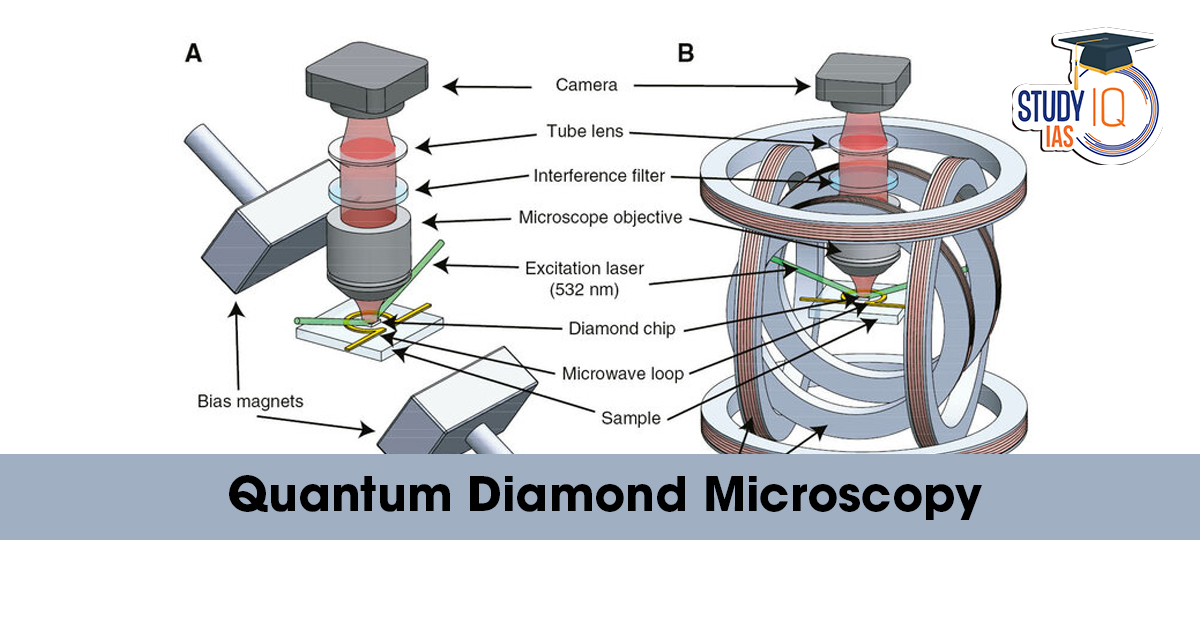Table of Contents
Quantum Diamond Microscopy (QDM) is an emerging quantum-sensing technology that allows scientists to image extremely small magnetic fields with nanometer-scale precision. As global research accelerates in quantum sensing, computing, and materials science, QDM has become one of the most promising tools. Recently, India made headlines with the launch of its first indigenous Quantum Diamond Microscope at IIT Bombay, marking a major stride toward quantum self-reliance under the National Quantum Mission (NQM).
What is Quantum Diamond Microscopy?
Quantum Diamond Microscopy is a cutting-edge imaging technique that uses nitrogen-vacancy (NV) centers in diamond to detect and visualize magnetic fields. Unlike traditional microscopes that rely on light or electrons, QDM maps magnetic signatures at the nanoscale, making it invaluable for physics, biology, electronics, and material sciences.
Key Features
-
Uses NV centers as quantum sensors
-
Detects magnetic fields in 2D & 3D
-
Provides non-destructive, high-resolution imaging
-
Works at room temperature, making it practical and versatile
How Quantum Diamond Microscopy Works
QDM relies on unique quantum properties of nitrogen-vacancy (NV) centers—tiny defects inside a diamond lattice.
1. Creation of NV Centers
An NV center forms when:
-
A nitrogen atom replaces a carbon atom
-
Adjacent to a vacancy (missing carbon atom)
These defects act as highly sensitive quantum sensors.
2. Optically Detected Magnetic Resonance (ODMR)
This is the fundamental working principle:
-
A laser is shone onto the NV centers
-
They emit fluorescence
-
The fluorescence changes based on the external magnetic field
-
These variations are converted into magnetic images
3. Magnetic Field Imaging
Using widefield or scanning modes, the microscope creates:
-
High-resolution maps of magnetic activity
-
Real-time dynamic images of magnetic phenomena
-
3D magnetic profiles across biological or electronic systems
This capability is significantly more advanced than conventional tools like electron microscopes or SQUID sensors.
Applications of Quantum Diamond Microscopy
1. Neuroscience and Brain Research
QDM allows scientists to:
-
Map magnetic activity of neurons
-
Track electrical signals in brain tissue
-
Study neurological disorders with unprecedented detail
Its non-invasive nature is a game-changer for live brain research.
2. Semiconductor and Chip Diagnostics
As chips evolve into 3D architectures, internal current flow becomes difficult to analyze.
QDM enables:
-
Layer-by-layer magnetic mapping
-
Failure detection in microchips
-
Visualization of current paths without damaging the device
This is crucial for autonomous vehicles, cryogenic processors, AI chips, and quantum devices.
3. Battery and Materials Science
QDM can study:
-
Ionic movement in batteries
-
Phase transitions in materials
-
Magnetic properties of layered structures
This helps improve battery safety, performance, and longevity.
4. Quantum Research and Fundamental Physics
The microscope helps researchers:
-
Study quantum materials
-
Investigate nanoscale magnetic textures
-
Explore superconductors, skyrmions, and spintronics
QDM is essential for developing next-generation quantum technologies.
Advantages of Quantum Diamond Microscopy
| Advantage | Explanation |
|---|---|
| Room-Temperature Operation | Works without cryogenic cooling |
| Non-Destructive Imaging | No damage to biological tissues or chips |
| Ultra-High Sensitivity | Detects extremely small magnetic fields |
| Nanoscale Resolution | Ideal for advanced electronics and materials |
| 3D Magnetic Imaging | Maps internal magnetic structures in real-time |
| Widefield Capability | Captures large areas at once |
India’s Breakthrough: Indigenous QDM by IIT Bombay
India’s first Quantum Diamond Microscope was developed by the P-Quest Group at IIT Bombay, led by Prof. Kasturi Saha. Launched at ESTIC 2025, the system positions India among the global leaders in quantum magnetic imaging.
Significance for India
-
Supports the National Quantum Mission (NQM)
-
Boosts indigenous quantum sensing technology
-
Helps build capabilities in chip diagnostics, defence, medicine, and materials
-
Marks India’s first patent in QDM magnetic imaging
This achievement underscores India’s push toward becoming a global quantum technology hub.
Future Prospects of Quantum Diamond Microscopy
Quantum Diamond Microscopy will play a critical role in:
-
Brain–machine interfaces
-
Quantum computers
-
High-density chip manufacturing
-
Renewable energy storage
-
Defence-grade magnetic sensing
-
Advanced medical diagnostics
With continued investments in quantum technologies, countries like India, the US, Japan, and Israel are emerging as key innovators.
Conclusion
Quantum Diamond Microscopy is not just a scientific tool — it is the future of high-precision diagnostics, quantum sensing, and nanoscale imaging. By harnessing the remarkable properties of NV centers in diamonds, QDM opens new frontiers in neuroscience, electronics, materials science, and quantum technology. India’s successful development of its first QDM marks a crucial step towards quantum self-reliance and positions the nation strongly in the growing global quantum ecosystem.


 State of the Cryosphere 2025 Report: Key...
State of the Cryosphere 2025 Report: Key...
 Climate Risk Index (CRI): Meaning, Metho...
Climate Risk Index (CRI): Meaning, Metho...
 Booker Prize 2025: David Szalay Wins for...
Booker Prize 2025: David Szalay Wins for...

























